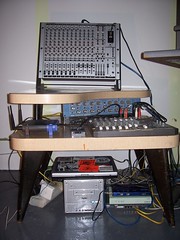
- Part I: Introduction to Podcasting and XML
- Part II: Creating Your Sound Files
- Part III: Creating Your XML File
- Part IV: Validating Your XML File
- Part V: Adding Your Podcast to the iTunes Directory
- Beyond the Basics I: Autolink From Your Website
- Beyond the Basics II: Using HTML Code in Your Description
Ok, there seems to be a lot of information out there on the internet on making podcasts, but nothing that really makes a lot of sense - I basically had to cobble together information from a lot of different sources in order to get mine up and running, so I thought I'd make a guide on how to produce your own podcast from start to finish, including the all-important getting it in iTunes steps. I'll also show you how to make your accompanying textual information for each episode to look nice in not just iTunes, but HTML readers like Google Reader as well, which is becoming just as important as iTunes.
First I'll explain a little about what a podcast actually is, for people that don't know - a podcast is basically like an internet newsletter - every time a new issue is produced, your computer automatically downloads the latest one. The difference between a podcast and a newsletter though is that a podcast can contain audio and video, meaning that you can set your computer up to automatically put the newly downloaded episode onto your mp3 player (no, it doesn't have to be an iPod, although Apple have made all this very easy with their iTunes software). There are podcasts on virtually anything, from just simple audio/video blogs to your favorite bands and language courses, and the best thing is that most of them are free! The beauty over traditional streaming internet media is that once you've subscribed to a podcast you like, you don't really have to do anything else to get any new episodes as they're produced, they come to you!
What you will need to make your first podcast:
- A text editor. Notepad will do, but if you want to use something more suited to web programming like Adobe Dreamweaver, it's up to you. I wouldn't recommend Microsoft Frontpage, as it seems to get in the way more than it helps you to do this.
- A sound/video editor for creating the episodes. Personally I use Adobe Audition 1.5, version 2 is out now, but for what I do, a lot of the features aren't necessary. If you got Nero with your CD Burner or your computer, there's a sound editor built into it. You'll probably also need a microphone, or some other way of getting sound into your computer.
- Some space on the internet somewhere. If you don't already have some, go to Googlepages for 100Mb free.
- iTunes is helpful, but not essential (most people who listen to podcasts do so through iTunes, so making your podcast iTunes compatible will increase your listenership by a huge amount). iTunes is also free, and is useful for adding album artwork to your episodes.
Now a bit of information about what actually makes the magic of a podcast happen. A podcast consists of one XML file, and many sound/video files. You're probably already familiar with sound and video files on your computer, so I'll save you an explanation of that. An XML file is basically a contents file: it just tells the computers subscribed to the podcast the location of each sound/video file, plus a description of the content of the files. It's this file which we'll be concentrating mostly in this tutorial. You'll have come across XML files more than you think as you browse around the internet - any time you see this symbol

All the information is the same, but it's presented in a much more structured and information-centric way (much like usenet groups used to be presented in days of yore, but with websites, instead of discussions), along with any other subscriptions listed to the left of the page, and without any of the website branding and images getting in the way.
Tomorrow I'll show you what a raw XML file looks like to us mere mortals, and how to create a podcast using this magical technology, for now, try going to a few of your favorite websites, and try subscribing to their feed by clicking the orange icon (if they have one), you never know, if you have a blog on the internet, you may have already created your own feed without realizing it!
On to Part 2...
Tomorrow I'll show you what a raw XML file looks like to us mere mortals, and how to create a podcast using this magical technology, for now, try going to a few of your favorite websites, and try subscribing to their feed by clicking the orange icon (if they have one), you never know, if you have a blog on the internet, you may have already created your own feed without realizing it!
On to Part 2...




Good Job!:)
ReplyDeleteGreat blog with such nice ideas! Thanks!
ReplyDelete